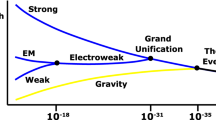Abstract
Since the deep paper by Bohr and Kalckar in 1938, it has been known that the Ramanujan formula in number theory is related to statistical physics and nuclear theory. From the early 1970s, there have been attempts to generalize number theory from the space of integers to the space of rational numbers, i.e., to construct a so-called analytic number theory. In statistical physics, we consider parameters such as the volume V, temperature T, and chemical potential μ, which are not integers and are consequently related to analytic number theory. This relation to physical concepts leads us to seek new relations in analytic number theory, and these relations turn out to be useful in statistical physics.
Similar content being viewed by others
References
L. D. Landau and E. M. Lifshitz, A Course in Theoretical Physics [in Russian], Vol. 5, Statistical Physics, Nauka, Moscow (1976); English transl., Pergamon, Oxford (1980).
A. G. Postnikov, Introduction to Analytic Number Theory [in Russian], Nauka, Moscow (1971).
N. Bohr and F. Kalckar, “On the transformation of atomic nuclei due to collisions with material particles [in Russian],” Uspekhi Fiz. Nauk, 20, 317–340 (1938).
V. P. Maslov, “Two-fluid picture of supercritical phenomena,” Theor. Math. Phys., 180, 1096–1129 (2014).
W.-S. Dai and M. Xie, “Gentile statistics with a large maximum occupation number,” Ann. Phys., 309, 295–305 (2004).
J. S. Bell, “On the Einstein Podolsky Rosen paradox,” Phys., 1, No. 3, 195–200 (1964).
V. P. Maslov, “Rotation of a neutron in the coat of Helium-5 as a classical particle for a relatively large value of the hidden parameter t meas,” Math. Notes, 103, No. 1, 67–74 (2018).
V. P. Maslov, “Statistical transition of the Bose gas to the Fermi gas,” Math. Notes, 103, No. 6, 3–9 (2018).
Author information
Authors and Affiliations
Corresponding author
Additional information
This research was supported by the Federal Target Program (Contract No. AAAA-A17-117021310377-1).
Translated from Teoreticheskaya i Matematicheskaya Fizika, Vol. 196, No. 1, pp. 161–166, July, 2018.
Rights and permissions
About this article
Cite this article
Maslov, V.P. New Formulas Related to Analytic Number Theory and Their Applications in Statistical Physics. Theor Math Phys 196, 1082–1087 (2018). https://doi.org/10.1134/S0040577918070127
Received:
Published:
Issue Date:
DOI: https://doi.org/10.1134/S0040577918070127



